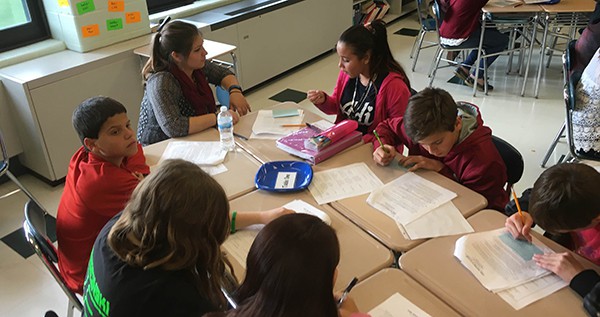Designing Learning Environments that Ensure Success for English Language Learners

It’s difficult to truly appreciate what the phrase “language barrier” means.
The closest I’ve ever come to simply not being able to communicate was during my freshman year of college. I was taking a biology class, and I remember sitting there and hearing the professor say words, but I had no idea what he was talking about, what the words meant, or how I was supposed to respond. The words and phrases meant nothing to me, yet when I looked around, there were other people taking notes, nodding, and conversing with him. I felt like an outsider, like I was in the wrong place, and I didn’t belong. My confidence was decimated, and I felt like yelling, “Wait! Come to my Shakespeare class. Come to American Literature. I’m not dumb. Really.” Most of us have “visited” times of having a language barrier like I’ve described, but few of us have lived it. As teachers, we must draw on our own experiences to foster an attitude of empathy, and do everything in our power to help English as a New Language Learners (ENLs) to flourish.
In addition to the language barrier, ENLs have an entirely different dilemma that classroom teachers can fail to recognize if they are not deliberately being culturally conscious and sensitive. Looking back, the reason I was lost in my biology class was because I had only taken a basic science class and didn’t have the background knowledge to put the words in any context.
Imagine an 8th grade social studies class. When the teacher says the words “Rosa Parks” the native speakers will recognize not only who she was, but also the lexicon surrounding the subject: boycott, civil rights, Martin Luther King, Jr, race, segregation, and many others, depending on their experiences. However, it is safe to say that students will have at least a cursory knowledge of the topic, a connotation at the very least. Yet, an ENL student is usually hearing all the words for the first time context free.
In an effort to better understand what classroom teachers should do to support ENLs, I interviewed Nicole Miller, a middle school ENL teacher in Hamburg, New York. She is currently writing curriculum to help define the classroom teacher’s role in an ENLs life and the significant impact our teaching and cultural responsiveness can have. Specifically, I wanted to understand how to help the students in my class navigate a project-based learning environment. Nicole Miller answers my questions in an interview here:
What challenges, in addition to the language barrier, do ENLs typically face when doing Project-based learning?
One of the major challenges that ENLs face is the lack of background knowledge about various topics that can lead to research for a project. For example, if we are launching a project about our current class novel study and the students are required to show what they have learned about race relations in the U.S., during the setting of the story this may prove to be a significant challenge.
Many ENLs may not have a strong sense of U.S. history and the struggles with race equality that native English speaking Americans would have. We teach about the struggles of race from a very young age in the U.S. and many of our ENLs will not have experienced the same instruction about this topic. ENLs might need specific scaffolding to understand the racial dynamics in the country.
Another challenge is the deadlines for projects. Often times the project deadlines are a bit of an issue because students at varying proficiency levels require varying levels of support and this can impact deadlines. ENLs often take longer to complete the same tasks as native English speaking students because of the demand in English to show proficiency and understanding.
Can you explain the role of parents (or not) of ENL students when it comes to providing support at home for their child?
Often times the parents or guardians of the student don’t speak English. This is a much bigger concern in low-income communities.. Parents may not understand what the student is required to do or how to access the information to help their child. The parents may not have access to community resources in their native language to explain how to borrow books from the library or use a particular website. Furthermore, the students may not have access to a computer or other technology required to complete a project. Additionally, some cultures and families might value success in the classroom differently. Some cultures hold other priorities alongside education such as religious and/or familial obligations.
What are some specific ways the classroom teacher can make sure that an ENL student is successful when assigning a project?
Be culturally sensitive and know what your students know. The teacher should work closely with the ENL teacher to ensure that the tasks assigned are linguistically appropriate for the students. Teachers can provide background information for the students and allow them to talk about their experiences with the topic.
Videos and field trips are awesome ways to create experiences for ENLs. This is important because it gives the students a chance to use English and create a shared experience.
ENLs may have very different experiences than your typical English speaking students. Channel their experiences. The teacher should set realistic expectations for the ENLs. All students desire to feel successful and this goes for ENLs, too! They are faced with unique challenges every day and the more successful they feel, the more confident they will become.
Classroom teachers should set frequent meetings with the ENLs to discuss the project and make sure that the ENLs are meeting the requirements. Teachers must be responsive and adjust the demands as needed. Chunk the tasks to make them more manageable.
The classroom teacher should also place the ENLs in a group with students that are proficient in English. Good models of the language are important as ENLs will often look to their peers for some support or guidance in the moment.
Be flexible. Present completed projects as examples. Model the expectations and what is acceptable. Don’t assume that your students know what to do. Check for understanding often. Differentiate for your students so you are causing their brains to sweat but not shut down. Work within their Zone of Proximal Development.
How do you think the language barrier should be handled in the presentation aspect of project-based learning?
I think that speaking in English in front of peers can be very intimidating for native English speakers and even more so for ENLs. I think that the students should have the opportunity to present if they choose. The teacher should push the student to do as much as they feel comfortable. Some ENLs go through a “silent period,” where they are not expressing any oral language in English.
Obviously, requiring this student to present should not happen. But, if you have a student who is social, enjoys participating in class, is confident and linguistically developed enough to present, they should!
I do not advise a student presenting in both languages with or without an interpreter. I teach in a free-standing ENL program. This does not allow for students to receive structured native and English language instruction.
Often times a student will not know the content language in their native language to successfully present a project. This is especially true when the student has little to no knowledge about the topic in their native language. The student will only be able to talk about the topic in English as this is the language of instruction. If I taught in a bilingual setting and the student received instruction in the content areas in both their native language and English, I would support them presenting bilingually.
Our conversation, I admit, left my head spinning. There is a definite need for the class Nicole Miller is designing, and I plan on being the first to sign up. Project-based learning can be complicated to begin with, so it is clear that very specific measures must be taken to ensure success for ENL students.
For more blogs by Amber, check out:
- Roadmap: The Get-It-Together Guide for Figuring Out What to Do with Your Life
- 3 Tips to Support Project-based Learning for Low-Income Students
- What Growth, Innovation and Collaborative Mindsets look like for Students and Teachers
Also check out our recently published The Next Generation of World Language Learning, a Getting Smart and Rosetta Stone Education white paper that describes a vision for next-gen world language learning and the opportunities blended learning creates for foreign language instruction.
Stay in-the-know with all things EdTech and innovations in learning by signing up to receive the weekly Smart Update.







0 Comments
Leave a Comment
Your email address will not be published. All fields are required.